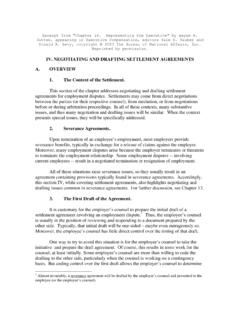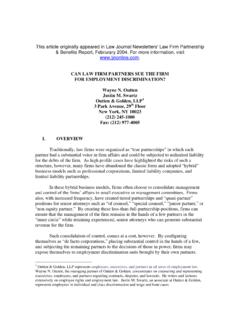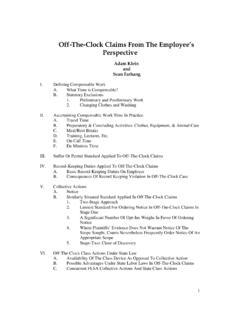Transcription of Settling the Case and Wrapping Up Employment: Negotiating ...
1 Settling THE CASE AND Wrapping UP employment : Negotiating strategies , drafting realities Wendi S. Lazar 46th ANNUAL PACIFIC COAST LABOR & employment LAW CONFERENCE SEATTLE, WASHINGTON APRIL 25 & 26, 2013 Outten & Golden, LLP 3 Park Avenue New York, NY 10016 (212) 245 1000 Wendi S. Lazar is Partner & Co Chair of the Executives and Professionals Practice Group at Outten & Golden LLP, has been practicing employment law since 1993, with a focus on representing employees in the negotiation of executive employment agreements, non competition and severance agreements, and multinational employment issues.
2 She also advises clients and other attorneys concerning employment . related immigration and international law. Martindale Hubbell recognizes Ms. Lazar as an AV Preeminent rated attorney, the highest such attorney rating available, and she was named to Best Lawyers in America 2012 in the field of employment Law Individuals. Ms. Lazar was also recognized by Super Lawyers in 2012. Ms. Lazar is the plaintiff Co Chair of the American Bar Association Labor and employment Law Section's International Labor and employment Law Committee. Ms. Lazar is also Diversity Co Chair and member of the Executive Committee of the New York State Bar Association Labor & employment Section.
3 Ms. Lazar is a published author and frequent lecturer on employment topics. All Rights Reserved Wendi S. Lazar March 2013 By Wendi S. Lazar I. Introduction For the employee, even the high level executive, separation or settlement agreements are often the first legal document that they have had to sign in regard to employment and often the first circumstance in which they have needed to hire counsel outside of a closing or a divorce. Negotiating and drafting these agreements can be a challenge for employee counsel. This is especially true for attorneys who represent executives.
4 With the amount of recent regulation in this area and the reluctance of companies to commit to employment agreements and severance plans, it is increasingly more difficult to protect the at will employee ahead of a downsizing or other termination event, leaving the employee vulnerable when her employment ends. Even when a contract of employment exists, there are other issues that may arise on account of the settlement or separation that were unforeseen, such as new tax or other government regulations or conditions on incentive compensation equity or new restrictive covenants.
5 Once the monetary package has been negotiated, issues of drafting become paramount and understanding the underlying case and statutory laws that guide certain provisions including those relevant to waivers and releases is key to achieving a balanced and equitable agreement for the client and giving her the best chance at re employment . II. Employee's Existing Obligations While knowing the client's entitlements are critical, being aware of her obligations post employment can also help to prevent liability in the future. Employees often have post employment obligations that they owe to their employers and these are often re confirmed in the separation agreement.
6 For most executives, these obligations will generally appear in an employment agreement, and/or confidentiality, non compete and non solicitation agreement executed prior to separation. Further, such obligations may be contained in the company's handbook, deferred compensation or equity plan. Knowing about these agreements or policies prior to any negotiation is important in order to protect the client from entering into new and unfair restrictions without additional and adequate Also, discerning if these restrictions pre dated the separation agreement is critical to any negotiation of terms, particularly in this economy, where restrictions can prevent an employee from becoming re.
7 Employed with a competitor.. Jennifer Liu, an Associate at Outten & Golden LLP, New York, assisted in the writing and research of this paper. 1. While there has not been a lot of litigation over non competes entered into after an employee's termination, there is some authority that such agreements are not enforceable. See Gorman Publishing Company v. Stillman, 516 F. Supp. 98, 108 ( Ill. 1980) ( [W]here, as here, a covenant not to compete is entered into after the underlying employment relationship is terminated, no enforceable rights arise. ); Marsh USA Inc.
8 V. Cook, 354 764, 771 72 (Tex. 2011) (observing that, in order to be valid and enforceable, a covenant not to compete must be ancillary' to another contract, transaction or relationship ); Rabinowitz v. Tillman, 192 535, 536 . 37 (Sup. Ct. 1959) ( A restrictive agreement entered into for a cash consideration after termination of employment is invalid. ); Bond Electric Corp. v. Keller, 113 195, 166 A. 341 (1933) (holding that a contract not to compete made after the defendant's employment terminated, and which was not incidental to the sale of a business or any other transaction, was invalid and unenforceable as an unreasonable restraint of trade).
9 2 For certain executives, these obligations may also be statutory or a matter of common law and will depend on the Again, reviewing these documents prior to any severance negotiation is important in order to determine what is an existing obligation and what can be traded or leveraged for additional consideration. Moreover, good lawyering demands that the client be informed of her obligations and what behaviors need to be avoided when employment ends to ensure that she doesn't become a defendant in a claim for breach of a restrictive covenant, fiduciary duty, or trade secret.
10 Finally, some states like New York will find certain restrictions unenforceable if the employee was terminated without cause or resigned for good reason because the underlying consideration for the restriction employment no longer This presents another opportunity to negotiate hard for adequate consideration if a restriction is introduced or even confirmed in the separation agreement. III. Final Steps Knowing When to Quit and Wrapping Up The most difficult place in a negotiation, is knowing when to stop pushing. Being sensitive to when the other side will not move any further, and may, in fact, be pushed too hard and start backtracking is essential.







